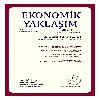An indicator of monetary conditions for Turkey
Türkiye için bir parasal koşullar göstergesi
___
- AGENOR, Pierre-Richard (2000), "Monetary policy under flexible exchange rates: An introduction to inflation targeting", World Bank Policy Research Working Paper, S. 2511.
- AKYÜZ, Yilmaz (2004), "Managing financial instability and shocks", Türkiye Ekonomi Kurumu Tartisma Metinleri, S. 2004/11.
- AKYÜZ, Yilmaz, BORATAV Korkut (2001), "The making of the Turkish financial crisis", Financialization of the Global Economy Congress, Political Economy Research Institute, University of Massachusetts Amherst, AmhersI.
- ARTETA, Carlos O. (2002), "Exchange rate regimes and financial dollarization: Does flexibility reduce bank currency mismatches?" Institute of Business and Economic Research Center for International and Development Economics Research Paper, S. 02/123 University of California, Berkeley.
- BALL, Laurence (1999), "Efficient rules for monetary policy", International Finance, C.2, S. 1,63-83.
- EICHENGREEN, Barry (2005), "Can emerging market s float? Should they inflation target?", in Exchange Rates, Capital Flows and Policy, (ed. Rebecca Driver, Christoph Thoenissen, Peter Sindair), Routledge, New York.
- EICHENGREEN, Barry, HAUSMANN, Ricardo (1999), "Exchange rates financial fragility", National Bureau of Economic Research Working Papers, S. 7418.
- EIKA,KariH.,ERICSSON,NeilR., and NYMOEN, Ragnar(1996), "Hazards in implementing a monetary conditions index", Board of Governors of the Federal Reserve System International Finance Discussion Papers, S.568.
- ERICSSON, NeilR., JANSEN, Eilev S., KERBESHIAN, NevaA., NYMOEN, Ragnar (1999), "Understanding amonetary conditions index", University of Oslo. http://folk. uio.no/rnymoen/EJKN _MCI_1997. pdf
- FILIZTEKIN, Alpay (2005), "Exchange rates and employment in Turkish manufacturing", International Finance, EconWPA, S. 0501004.
- FREEDMAN, Charles (1994), "The use of indicators and of the monetary conditions index in Canada", in Frameworks for Monetary Stability: Policy Issues and Country Experiences, (ed. T.J.T. Balino, C. Cottarelli), International Monetary Fund, Washington, D.C., ss. 458-476.
- GAUTHIER, Celine, GRAHAM, Christopher, LIU, Ying (2004), "Financial conditions indexes for Canada", Bank of Canada Working Paper, S. 2004-22.
- GOODHART Charles, HOFMANN, Boris (2001), "Asset prices, financial conditions and the transmission of monetary policy", Asset Prices, Exchange Rates, and Monetary Policy Congress, Stanford University, Stanford.
- GUENDER, Alfred v., MATHESON, Troy (2002), "Design flaws in the constmction ofmonetary conditions indices? A cautionary note", New Zealand Economic Papers, C. 36, S. 2, 209-215.
- KARA, Ali Hakan (2006), "Turkish experience with implicit inflation targeting", TCMB Çalisma Tebligleri, S. 06/03.
- KESRIYELI, Mehtap, KOÇAKER, I. Ilhan (1999), "Monetary conditions index: A monetary policy indicator for Turkey", TCMB Tartisma Tebligleri, S. 9908.
- LACK, Caesar P. (2002), "Afinancial conditions index for Switzerland", BIS Autumn Central Bank Economist Meeting, BaseL.
- SAHINBEYOGLU, Gülbin (2001), "Monetary transmission mechanism: A view from a high inflationary environment", TCMB Tartisma Tebligleri, S.2001/1.
- TÜRKAN, Ercan (2006), Türkiye 'de üretimin ithalat ve ihracat bagimliligi, TCMB, Ankara.
- TÜRKIYE CUMHURIYET MERKEZ BANKASI (2005), "Enflasyon Hedeflernesi Rejiminin Genel çerçevesi ve 2006 Yilinda Para ve Kur Politikasi", Basin Duyurulan, S. 2005-56.
- US, Vuslat (2004), "Monetary transmission mechanism in Turkey under the monetary conditions index: An alternative policy mle", Applied Economics, 2004, S. 36,967-976.
- ISSN: 1300-1868
- Yayın Aralığı: 3
- Yayıncı: Ekonomik Yaklaşım Derneği
Modern ile postmodern paradigmanın cumhuriyet nosyonu üzerine etkileri
Dünya enerji tüketimi:1980-2005 döneminde enerji tüketimindeki değişim
Harun ÖZTÜRKLER, A. Hakan ÇERMİKLİ
Alfred Marshall, John Maynard Keynes ve 'iktisat ile etik' ilişkisi
Ormanda mülkiyet hakları mücadelesi ve Orman Kanunu'nun 2/B düzenlemesi
Kamu borçlanması kamu yatırımlarını dışlıyor mu?
Oktay Orçun BEKEN, Mehmet DURKAYA, Servet CEYLAN
